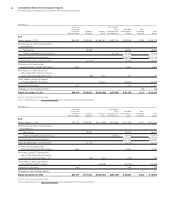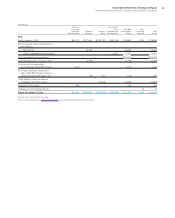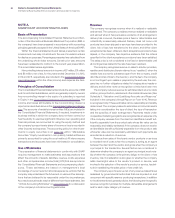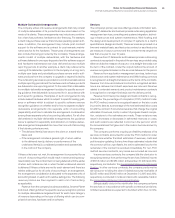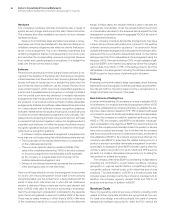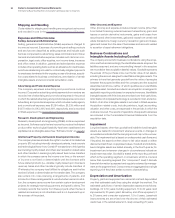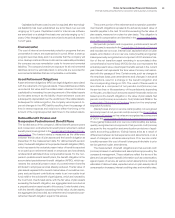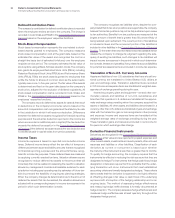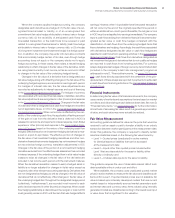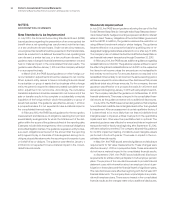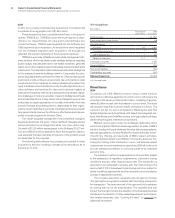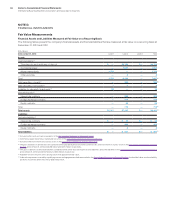IBM 2013 Annual Report Download - page 91
Download and view the complete annual report
Please find page 91 of the 2013 IBM annual report below. You can navigate through the pages in the report by either clicking on the pages listed below, or by using the keyword search tool below to find specific information within the annual report.
Notes to Consolidated Financial Statements
International Business Machines Corporation and Subsidiary Companies
90
Defined Contribution Plans
The company’s contribution for defined contribution plans is recorded
when the employee renders service to the company. The charge is
recorded in Cost, SG&A and RD&E in the Consolidated Statement of
Earnings based on the employees’ respective functions.
Stock-Based Compensation
Stock-based compensation represents the cost related to stock-
based awards granted to employees. The company measures
stock-based compensation cost at the grant date, based on the
estimated fair value of the award and recognizes the cost on a
straight-line basis (net of estimated forfeitures) over the employee
requisite service period. The company estimates the fair value of
stock options using a Black-Scholes valuation model. The company
also grants its employees Restricted Stock Units (RSUs), including
Retention Restricted Stock Units (RRSUs) and Performance Share
Units (PSUs). RSUs are stock awards granted to employees that
entitle the holder to shares of common stock as the award vests,
typically over a one- to five-year period. The fair value of the awards
is determined and fixed on the grant date based on the company’s
stock price, adjusted for the exclusion of dividend equivalents. All
stock-based compensation cost is recorded in Cost, SG&A, and
RD&E in the Consolidated Statement of Earnings based on the
employees’ respective functions.
The company records deferred tax assets for awards that result
in deductions on the company’s income tax returns, based on the
amount of compensation cost recognized and the statutory tax rate
in the jurisdiction in which it will receive a deduction. Differences
between the deferred tax assets recognized for financial reporting
purposes and the actual tax deduction reported on the income tax
return are recorded in additional paid-in capital (if the tax deduction
exceeds the deferred tax asset) or in the Consolidated Statement
of Earnings (if the deferred tax asset exceeds the tax deduction and
no additional paid-in capital exists from previous awards).
Income Taxes
Income tax expense is based on reported income before income
taxes. Deferred income taxes reflect the tax effect of temporary
differences between asset and liability amounts that are recognized
for financial reporting purposes and the amounts that are recog-
nized for income tax purposes. These deferred taxes are measured
by applying currently enacted tax laws. Valuation allowances are
recognized to reduce deferred tax assets to the amount that will
more likely than not be realized. In assessing the need for a valuation
allowance, management considers all available evidence for each
jurisdiction including past operating results, estimates of future tax-
able income and the feasibility of ongoing tax planning strategies.
When the company changes its determination as to the amount of
deferred tax assets that can be realized, the valuation allowance is
adjusted with a corresponding impact to income tax expense in the
period in which such determination is made.
The company recognizes tax liabilities when, despite the com-
pany’s belief that its tax return positions are supportable, the company
believes that certain positions may not be fully sustained upon review
by tax authorities. Benefits from tax positions are measured at the
largest amount of benefit that is greater than 50 percent likely of
being realized upon settlement. The current portion of tax liabilities
is included in taxes and the noncurrent portion of tax liabilities is
included in other liabilities in the Consolidated Statement of Financial
Position. To the extent that new information becomes available which
causes the company to change its judgment regarding the ade-
quacy of existing tax liabilities, such changes to tax liabilities will
impact income tax expense in the period in which such determina-
tion is made. Interest and penalties, if any, related to accrued liabilities
for potential tax assessments are included in income tax expense.
Translation of Non-U.S. Currency Amounts
Assets and liabilities of non-U.S. subsidiaries that have a local func-
tional currency are translated to United States (U.S.) dollars at
year-end exchange rates. Translation adjustments are recorded
in OCI. Income and expense items are translated at weighted-aver-
age rates of exchange prevailing during the year.
Inventories, property, plant and equipment—net and other non-
monetary assets and liabilities of non-U.S. subsidiaries and
branches that operate in U.S. dollars are translated at the approxi-
mate exchange rates prevailing when the company acquired the
assets or liabilities. All other assets and liabilities denominated in a
currency other than U.S. dollars are translated at year-end exchange
rates with the transaction gain or loss recognized in other (income)
and expense. Income and expense items are translated at the
weighted-average rates of exchange prevailing during the year.
These translation gains and losses are included in net income for
the period in which exchange rates change.
Derivative Financial Instruments
Derivatives are recognized in the Consolidated Statement of Finan-
cial Position at fair value and are reported in prepaid expenses and
other current assets, investments and sundry assets, other accrued
expenses and liabilities or other liabilities. Classification of each
derivative as current or noncurrent is based upon whether
the maturity of the instrument is less than or greater than 12 months.
To qualify for hedge accounting, the company requires that the
instruments be effective in reducing the risk exposure that they are
designated to hedge. For instruments that hedge cash flows, hedge
designation criteria also require that it be probable that the under-
lying transaction will occur. Instruments that meet established
accounting criteria are formally designated as hedges. These criteria
demonstrate that the derivative is expected to be highly effective
at offsetting changes in fair value or cash flows of the underlying
exposure both at inception of the hedging relationship and on an
ongoing basis. The method of assessing hedge effectiveness
and measuring hedge ineffectiveness is formally documented at
hedge inception. The company assesses hedge effectiveness and
measures hedge ineffectiveness at least quarterly throughout the
designated hedge period.




